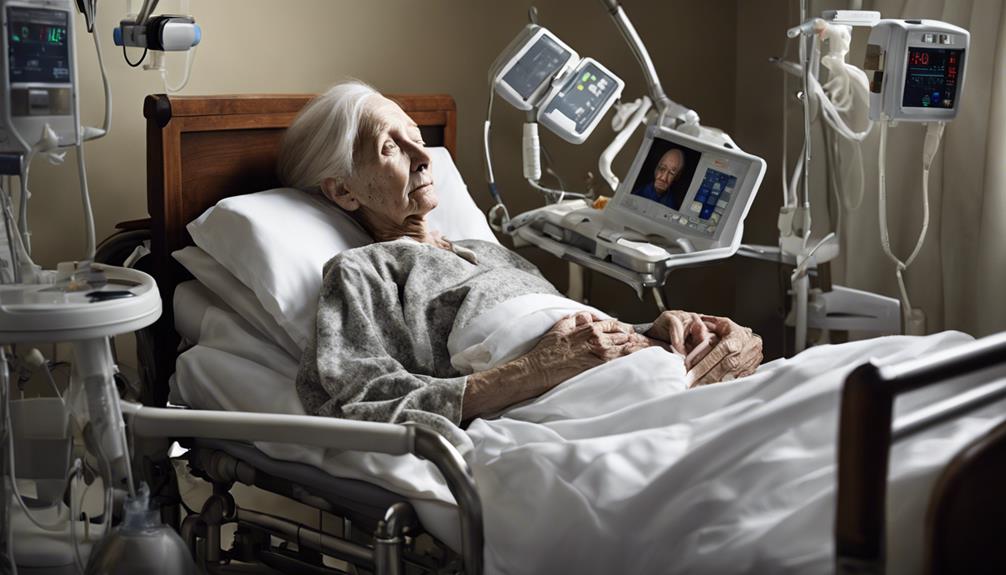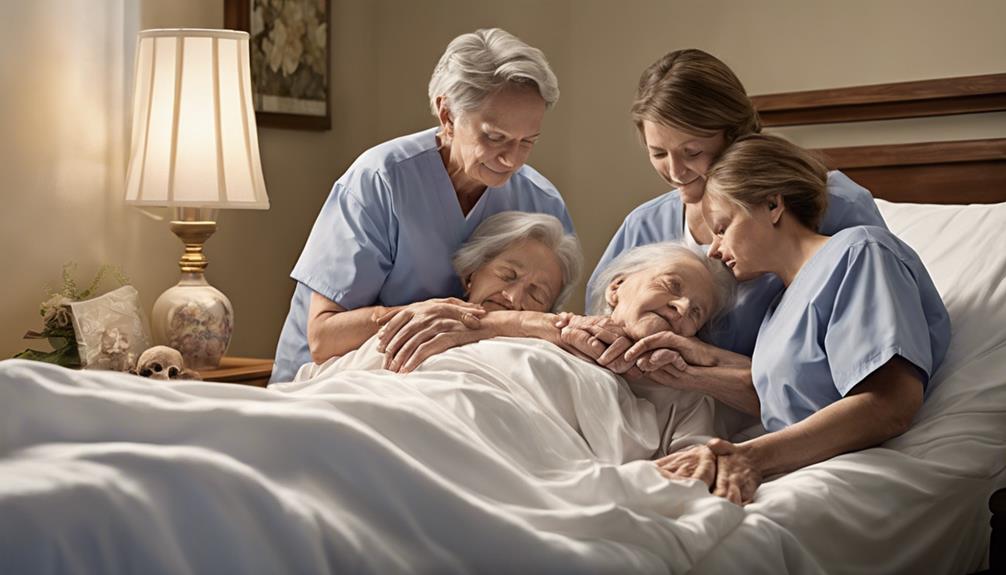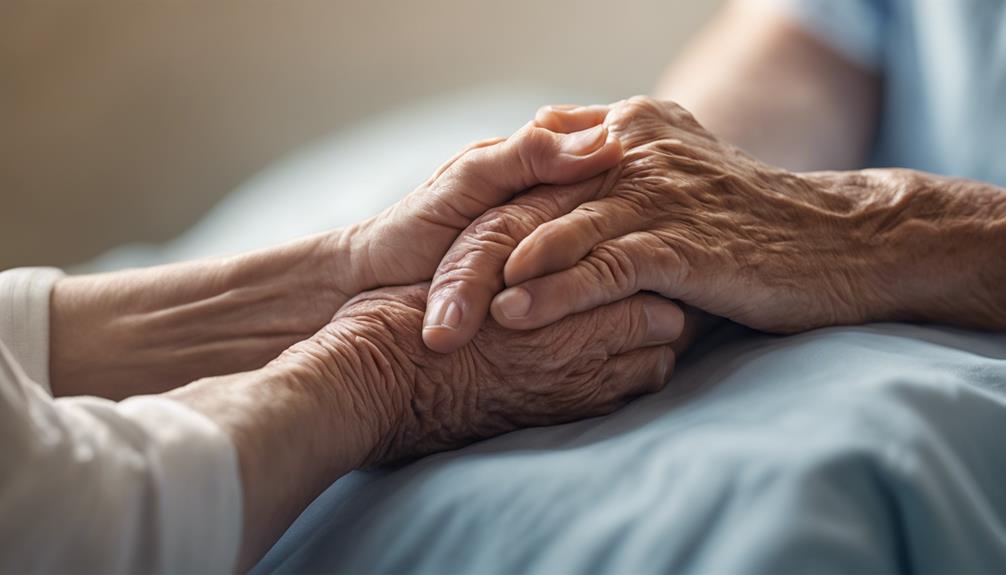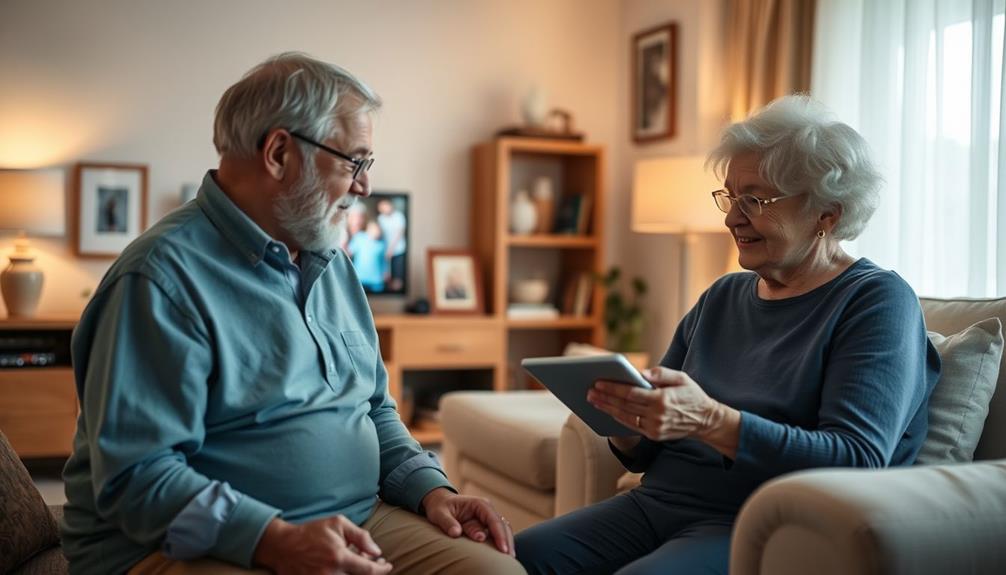Hospice patients can live without eating for varying times, influenced by fluid intake, body reserves, and health. Factors include dehydration leading to kidney issues within days. Some lose hunger and thirst naturally. Monitoring nutrition is essential. Medical conditions impact ability to go without food, with reserves sustaining weeks. Bedridden patients last days to weeks without eating. Responses differ; some live days, others weeks. Individual care is important—some need artificial nutrition, others don't. Respecting natural progression is key. Further information on managing pain, ethical considerations, and compassionate care awaits.
Key Takeaways
- Survival without eating varies, from days to weeks, based on health and conditions.
- Loss of appetite in natural dying process may lead to weeks of survival without food.
- Monitoring nutrition and hydration levels is crucial for comfort and well-being.
- Tailoring care to individual needs impacts survival duration without eating.
- Respecting patient autonomy and choices regarding food and water intake is essential in hospice care.
Factors Affecting Survival Timeline
Factors affecting the survival timeline of hospice patients primarily revolve around fluid intake and body reserves. For patients in hospice care, the ability to survive without food varies depending on their overall health and specific circumstances. While the body can rely on its reserves for sustenance for several weeks without eating, the lack of fluid intake poses a more immediate threat.
Dehydration can lead to kidney function issues within a few days, impacting the patient's overall well-being. In the natural dying process, individuals may lose their sense of hunger and thirst, signaling the body's gradual shutdown. It's essential for caregivers and healthcare providers to monitor patients' nutrition and hydration levels closely, especially in End-of-Life Care situations.
Understanding the delicate balance between food intake, fluid intake, and the body's reserves is crucial in providing the best care for patients nearing the end of their lives.
Impact of Medical Conditions

Medical conditions can greatly impact how long hospice patients live without eating. The progression of diseases and potential complications from treatments can affect a patient's ability to go without food for an extended period.
Understanding how specific medical conditions influence a patient's survival timeline is essential in providing appropriate care during this delicate phase.
Disease Progression Effects
As patients in hospice care progress through advanced medical conditions, their ability to consume food naturally diminishes, impacting their overall health and well-being. Disease progression leads to a natural decline in appetite, resulting in a loss of hunger, especially in end-of-life stages. The body's reserves, stored from food intake, can help sustain some hospice patients for several weeks without eating. Bedridden individuals requiring minimal fluid intake may survive for a few days to a couple of weeks without food. This process signifies the body's natural shutting down as it prepares for the end-of-life stages. Below is a table summarizing the effects of disease progression on hospice patients:
| Disease Progression Effects |
|---|
| Natural decline in appetite |
| Loss of hunger |
| Body's reserves utilization |
Treatment Complications Implications
Occasionally, treatment complications in hospice care present significant implications on the overall well-being of patients, directly influenced by their medical conditions. Complications arising from the natural progression towards the end of life can impact survival time for hospice patients. These complications may include kidney issues due to the lack of food intake, which can affect the body's ability to sustain itself during the dying process.
While hospice patients can survive for approximately two weeks without eating, individual cases may vary, with some patients lasting longer. Additionally, the loss of hunger and thirst signals the body shutting down, indicating the body's reserves are depleting.
Understanding these implications is vital in providing appropriate care and support to hospice patients during this challenging time in hospice care.
Individual Patient Response
Individual patient response to not eating in hospice care varies greatly due to factors such as overall health, hydration status, and underlying conditions.
Some may survive for a few days without eating, while others can last several weeks without food.
Understanding these nuances is pivotal for providing tailored care and support to hospice patients and their families.
Impact of Fasting
During the end-of-life phase, hospice patients exhibit varying responses to fasting based on their unique health conditions and individual needs. The impact of fasting on a patient's quality of life and survival time can differ depending on factors like hydration levels and the normal dying process.
Some patients may find artificial nutrition unnecessary as the body naturally adjusts to the shutting down process. Understanding the individual's response to fasting is vital in providing appropriate care and support tailored to their specific circumstances.
It's essential to respect the body's natural progression during this phase and guarantee that the patient's comfort and dignity are maintained throughout their journey.
Palliative Care Considerations
In considering palliative care for hospice patients, we prioritize understanding their unique responses to treatment interventions. Each patient in hospice care may react differently to the absence of nutrition, affecting how long they can live without eating. It's essential to tailor the care provided to meet each patient's specific needs and preferences.
While some hospice patients may survive for about 10 days without food, others, in rare cases, can live for several weeks. The body's reserves from food stores play a significant role in sustaining hospice patients during this time. Loss of hunger and thirst often indicates the body's natural process of shutting down in the dying phase.
The duration of survival without eating varies based on individual health conditions and the quality of care received in hospice settings.
Support for Families
As families navigate the challenges of supporting their loved ones in hospice care, offering small gestures like providing minimal nutrition or hydration can make a significant impact on the patient's comfort and well-being.
Family members play an important role in providing emotional support and respecting the patient's choices during this time. In hospice care plans, it's vital to focus on comfort care and individualized support tailored to the patient's wishes.
While patients close to death may only require minimal nourishment, alternative forms of comfort such as conversation and touch can bring solace. By respecting the choices of the patient regarding food and water intake, family members can contribute to creating a peaceful and supportive environment during the dying process.
Role of Hospice Care

Providing comfort and support in the natural dying process, hospice care plays a crucial role in honoring patients' wishes and ensuring dignified end-of-life care. In hospice care, health care providers and the hospice team work together to address the physical, emotional, and spiritual needs of individuals facing a terminal illness.
This specialized care involves recognizing the signs of the dying process and focusing on symptom management to alleviate pain and discomfort. Hospice professionals are trained to respect patients' wishes regarding treatment decisions, including the option of withholding food and water when appropriate.
Support for Families and Caregivers

Supporting families and caregivers involves understanding the importance of providing comfort and assistance during the end-of-life journey of their loved ones in hospice care. Caregivers play an essential role in ensuring the well-being of the patient, especially when it comes to nutrition and hydration.
Family members can offer small sips of water or other liquids to the patient if they're still able to intake them. Keeping the patient's lips and mouth moist is critical for their comfort, even if they're unable to drink. Additionally, providing emotional support is necessary during this challenging time.
Respecting the patient's wishes regarding nutrition and hydration is fundamental in honoring their autonomy and dignity. Alternative forms of nourishment, such as engaging in meaningful conversations and offering gentle touch, can also provide comfort and support to the patient.
Seeking guidance from the hospice team on oral care, comfort measures, and nutrition strategies can help caregivers better support their loved ones through this journey.
Managing Pain and Symptoms

Optimizing comfort and alleviating distress are paramount in managing pain and symptoms for patients in hospice care. Pain management is an essential aspect of hospice care, guaranteeing that patients are as comfortable as possible during their end-of-life journey. Symptoms such as pain, nausea, breathing difficulties, and anxiety are common in hospice patients and require careful attention and treatment. Individual needs play a significant role in determining the best approach to managing pain and symptoms, as each patient may experience unique challenges.
In addition to pain management, the evaluation of hydration levels is critical for patients nearing the end of life in hospice care. Daily assessments help healthcare providers determine the most appropriate interventions to maintain comfort and quality of life. Understanding the survival time without eating can also guide healthcare teams in developing personalized care plans that address the specific needs of each patient. By focusing on managing pain and symptoms effectively, hospice care providers can guarantee that patients receive the support and comfort they deserve during this challenging time.
Importance of Monitoring

Monitoring hydration and nutrition levels is a critical aspect of hospice care for guaranteeing the comfort and well-being of patients nearing the end of life. Hospice teams play an essential role in observing the significance of monitoring these aspects. By keeping a close eye on hydration and nutrition needs, hospice teams can help identify any declining signs early on. The body's reserves from food stores can sustain patients for a significant period without eating, but it's important to monitor these levels to prevent discomfort.
Hospice teams are trained to recognize subtle changes that may indicate a decline in hydration or nutrition. This monitoring helps guarantee that patients are as comfortable as possible during their end-of-life journey. By staying attentive to these needs, hospice teams can provide the necessary support and care to maintain the best quality of life for their patients. Proper monitoring allows for timely interventions and adjustments to guarantee that patients receive the care they need during this delicate time.
Ethical Considerations in Care

Observing ethical considerations in hospice care involves respecting the autonomy and values of patients and their families, particularly in decisions concerning nutrition and hydration. When caring for individuals in their end-of-life stages, ethical dilemmas may arise. Here's how we navigate them:
- Patient Autonomy: Prioritizing the wishes of the patient is essential in hospice care. They should be actively involved in decision-making processes regarding their nutrition and hydration needs.
- Family Involvement: While patient autonomy is key, family members also play an important role in supporting the patient's decisions. Their input should be considered and respected.
- Respecting Choices: If a patient refuses food or water, or is unable to safely consume them, ethical care may involve discontinuing these provisions. Respecting the patient's wishes in such situations is paramount in hospice care.
Compassionate End-of-Life Planning

As we guide patients through their end-of-life journey, compassionate end-of-life planning is essential for ensuring their comfort and dignity.
Hospice care focuses on creating individualized care plans that honor the patient's wishes regarding nutrition and hydration. During the dying process, the body naturally shuts down hunger and thirst, and caregivers provide comfort and support to alleviate any discomfort.
Understanding the importance of end-of-life planning in hospice care allows us to tailor our approach to meet the unique needs of each patient. By prioritizing comfort and support, we can help patients find peace and dignity in their final days.
It's critical to communicate openly with healthcare providers and loved ones to make sure that the patient's wishes are respected and that they receive the compassionate care they deserve. Through thoughtful end-of-life planning, we can help patients navigate this challenging time with grace and compassion.
Frequently Asked Questions
How Long Do Hospice Patients Live After They Stop Eating?
We acknowledge the concern about hospice patients living after they cease eating. Normally, in such scenarios, patients may endure for approximately two weeks without food. Our team endeavors to offer comfort and assistance during this sensitive period.
Which Signs Would You Notice if the End of Life Is Near?
As the end nears, signs like decreased appetite, swallowing difficulties, and increased sleepiness become evident. Patients may lose interest in food, experience weight loss, and exhibit minimal fluid intake. These changes signal the body's preparation for the final journey.
What Are the Three Stages of the Body Shutting Down?
As the body shuts down, it progresses through three stages involving decreased appetite, energy conservation, and decline in consciousness. These natural processes signal the end of life, allowing us to offer appropriate care and comfort.
How Do You Know When a Person Is Transitioning and Actively Dying?
When a person is approaching the end of life and actively dying, we notice decreased appetite, increased sleep, and changes in breathing patterns. Signs like restlessness and skin color changes may signal the process. Healthcare providers guarantee comfort and support.
Conclusion
To summarize, the survival timeline for hospice patients who stop eating can vary depending on various factors. Medical conditions, individual patient response, hospice care, and pain management all play a role in determining how long a patient may live without eating.
It's important for families and caregivers to provide support, monitor the patient closely, and make compassionate end-of-life plans. They should also encourage open discussions about feelings and concerns, creating an environment where the patient feels heard and valued. Offering access to bereavement counseling or therapy can be crucial, especially for those struggling afterward. Effective complicated grief treatment is essential for individuals finding it difficult to adjust to loss, helping them process their emotions and move towards healing in a healthy way.
Hospice care focuses on comfort and quality of life, ensuring that patients are well-supported during this difficult time.









